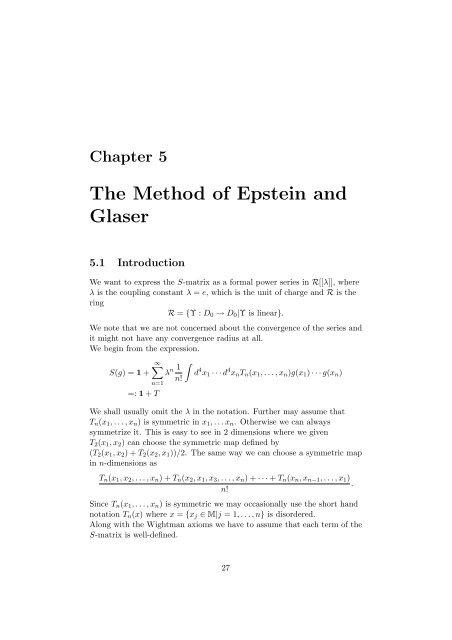Master Dissertation
Master Dissertation
Master Dissertation
Create successful ePaper yourself
Turn your PDF publications into a flip-book with our unique Google optimized e-Paper software.
Chapter 5<br />
The Method of Epstein and<br />
Glaser<br />
5.1 Introduction<br />
We want to express the S-matrix as a formal power series in R[[λ]], where<br />
λ is the coupling constant λ = e, which is the unit of charge and R is the<br />
ring<br />
R = {Υ : D0 → D0|Υ is linear}.<br />
We note that we are not concerned about the convergence of the series and<br />
it might not have any convergence radius at all.<br />
We begin from the expression.<br />
S(g) = 1 +<br />
∞<br />
n=1<br />
=: 1 + T<br />
<br />
n 1<br />
λ<br />
n!<br />
d 4 x1 · · · d 4 xnTn(x1, . . . , xn)g(x1) · · · g(xn)<br />
We shall usually omit the λ in the notation. Further may assume that<br />
Tn(x1, . . . , xn) is symmetric in x1, . . . xn. Otherwise we can always<br />
symmetrize it. This is easy to see in 2 dimensions where we given<br />
T2(x1, x2) can choose the symmetric map defined by<br />
(T2(x1, x2) + T2(x2, x1))/2. The same way we can choose a symmetric map<br />
in n-dimensions as<br />
Tn(x1, x2, . . . , xn) + Tn(x2, x1, x3, . . . , xn) + · · · + Tn(xn, xn−1, . . . , x1)<br />
.<br />
n!<br />
Since Tn(x1, . . . , xn) is symmetric we may occasionally use the short hand<br />
notation Tn(x) where x = {xj ∈ M|j = 1, . . . , n} is disordered.<br />
Along with the Wightman axioms we have to assume that each term of the<br />
S-matrix is well-defined.<br />
27



